Discover the hidden ways employees may be stealing from your bar and how to prevent it.
Understanding the impact of employee theft in bars
Employee theft in bars can have a significant impact on the business, both financially and reputationally. The stolen items or money can result in immediate losses for the bar, affecting its profitability. Additionally, employee theft can damage the trust and loyalty of customers, leading to a decline in patronage. It is crucial for bar owners to understand the negative consequences of employee theft in order to take appropriate measures to prevent it.
Another paragraph about understanding the impact of employee theft in bars.
Common methods of employee theft in bars
There are various common methods that employees may use to steal from bars. One method is skimming, where employees take cash directly from the register before it is recorded. Another method is over-pouring, where bartenders pour excessive amounts of alcohol into drinks and pocket the difference. Employees may also engage in undercharging, where they deliberately charge customers less than the actual price of the items. Additionally, theft of inventory such as liquor bottles or food supplies is another common method of employee theft in bars.
Another paragraph about common methods of employee theft in bars.
Signs to look out for in detecting employee theft
There are several signs that bar owners can look out for to detect employee theft. One sign is a discrepancy between the amount of cash recorded in the register and the actual cash on hand. If the numbers don't match up, it could be an indication of theft. Another sign is a sudden increase in inventory shrinkage or missing items. Unexplained changes in employee behavior, such as a reluctance to take time off or a sudden change in personal appearance, can also be red flags. It is important to be vigilant and observant to identify potential signs of employee theft.
Another paragraph about signs to look out for in detecting employee theft.
Preventative measures to combat employee theft
To combat employee theft in bars, there are several preventative measures that can be implemented. First and foremost, it is important to have a strong hiring process in place, including thorough background checks and reference checks. Implementing a system of checks and balances, such as having multiple employees involved in cash handling and inventory management, can help deter theft. Regular inventory audits and surprise cash register counts can also help identify any discrepancies. Proper training and clear communication of expectations can also play a crucial role in preventing employee theft.
Another paragraph about preventative measures to combat employee theft.
Legal implications and consequences of employee theft in bars
Employee theft in bars can have serious legal implications and consequences. Depending on the severity of the theft, employees can face criminal charges and potential jail time. Bar owners may also pursue civil litigation to recover damages caused by the theft. In addition to legal consequences, employee theft can result in termination of employment and damage to the employee's professional reputation. It is important for both bar owners and employees to be aware of the potential legal ramifications of employee theft.
Another paragraph about legal implications and consequences of employee theft in bars.
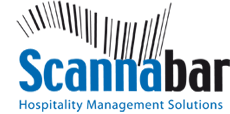
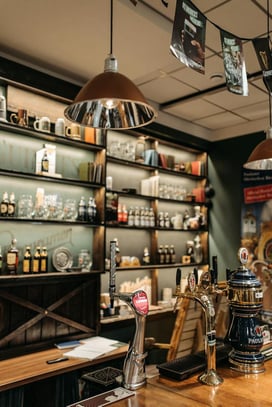
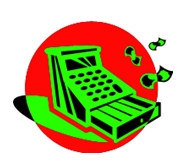 Money losers in a bar come in many forms, and you will want to check your financial records carefully to make sure that you are not being affected by one of these:
Money losers in a bar come in many forms, and you will want to check your financial records carefully to make sure that you are not being affected by one of these: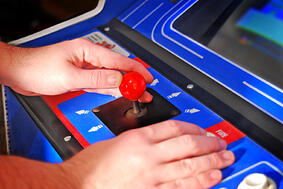 Coin-operated entertainment machines are a great source of extra revenue for a bar. The eclectic nature of most bars means that coin-ops of all styles, sizes, and functions can fit perfectly within your surrounds while adding to the fun and flavor of your establishment. The profits that coin-ops generate can be huge; they can also run a lot deeper than just the money inserted into the machines.
Coin-operated entertainment machines are a great source of extra revenue for a bar. The eclectic nature of most bars means that coin-ops of all styles, sizes, and functions can fit perfectly within your surrounds while adding to the fun and flavor of your establishment. The profits that coin-ops generate can be huge; they can also run a lot deeper than just the money inserted into the machines.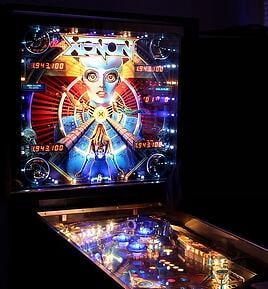 The trusty pinball machine has been around since the late 1800s yet still uses the same formula as the pinball machines of old. Lights, sound effects, the bounce of the ball, the sound of the flipper, and the lure of a high score. With a little smart thinking, your pinball machines can earn you a lot of money.
The trusty pinball machine has been around since the late 1800s yet still uses the same formula as the pinball machines of old. Lights, sound effects, the bounce of the ball, the sound of the flipper, and the lure of a high score. With a little smart thinking, your pinball machines can earn you a lot of money. New technology. Look at what's available on the market today. The dartboard has received a technological boost. Coin-operated dart systems not only keep score for your patrons, but they also bring in a new source of revenue. Turnkey systems can be purchased or brought in under a profit-sharing deal.
New technology. Look at what's available on the market today. The dartboard has received a technological boost. Coin-operated dart systems not only keep score for your patrons, but they also bring in a new source of revenue. Turnkey systems can be purchased or brought in under a profit-sharing deal.
 The savvy bar manager knows how to maximize profits and get the most sales possible without sacrificing ethics or drink quality. You can do the same if you follow a few simple tips. One simple way to maximize profits is by offering promotions or discounts. The small cost factor involved in initiating these promotions make them a good promotional vehicle.
The savvy bar manager knows how to maximize profits and get the most sales possible without sacrificing ethics or drink quality. You can do the same if you follow a few simple tips. One simple way to maximize profits is by offering promotions or discounts. The small cost factor involved in initiating these promotions make them a good promotional vehicle. Another way to maximize spending, and your bar's profits, is with bar tabs. Bar tabs make it easier for customers to spend without hassle, encouraging multiple orders of drinks. To allow bar tabs or not is a policy that can be debated from both sides with sound reasoning. Many bars and restaurants have been victimized by customers who walk out and do not pay their tabs. A policy of no bar tabs will alleviate the initial problem, but it will certainly be inconvenient—and possibly insulting—to some customers.
Another way to maximize spending, and your bar's profits, is with bar tabs. Bar tabs make it easier for customers to spend without hassle, encouraging multiple orders of drinks. To allow bar tabs or not is a policy that can be debated from both sides with sound reasoning. Many bars and restaurants have been victimized by customers who walk out and do not pay their tabs. A policy of no bar tabs will alleviate the initial problem, but it will certainly be inconvenient—and possibly insulting—to some customers.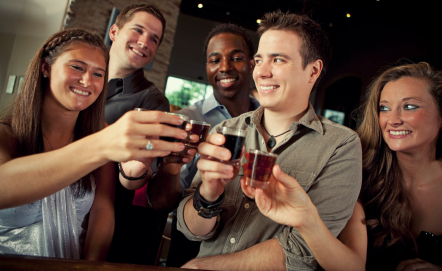 Your market and competitor research will likely reveal that most bars that are successful pay a lot of attention to customers. In fact, great service is one of the surest ways of drawing repeat customers. To draw more patrons to your bar on a regular basis, you do not have to spend a lot of money. However, you do have to think like a customer; you will likely notice a few things that need to change at your establishment:
Your market and competitor research will likely reveal that most bars that are successful pay a lot of attention to customers. In fact, great service is one of the surest ways of drawing repeat customers. To draw more patrons to your bar on a regular basis, you do not have to spend a lot of money. However, you do have to think like a customer; you will likely notice a few things that need to change at your establishment: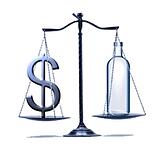 Industry studies have consistently shown that a full 25% to 30% of a bar's liquor inventory never converts into registered sales. That is the equivalent of about six to eight 1.25 oz portions per bottle (which should yield at least 25 portions.) This loss of liquor volume--due to unauthorized comps, over-pouring, spillage or theft--should be of great concern to any bar manager.
Industry studies have consistently shown that a full 25% to 30% of a bar's liquor inventory never converts into registered sales. That is the equivalent of about six to eight 1.25 oz portions per bottle (which should yield at least 25 portions.) This loss of liquor volume--due to unauthorized comps, over-pouring, spillage or theft--should be of great concern to any bar manager. 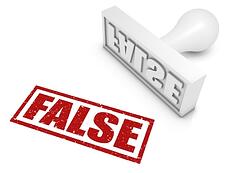 Many of the best bartenders learn most of their useful trade while at work. This is because bartending schools vary widely in quality. Some emphasize the preparation of rarely requested drinks without stressing useful skills such as bar management, customer satisfaction, and customer safety. If you are hiring a bartender, you should consider the school he or she has attended, but testing practical skills will give the best clue of how many useful skills the person has for waiting on your bar. If you are considering attending a bartending school, investigate the school to make sure that you will be taught skills such as organization and techniques of serving. A good bartending school or course will emphasize dealing with customers. Be wary of a bartending school that is more of a "drink mix" school, stressing mixing many types of drinks without teaching anything besides drink preparation. There are many of these sorts of schools out there, which claim that a bartender's greatest asset is knowing how to mix an endless variety of drinks. Learning to mix the latest drink is relatively simple once one looks up the recipe, and most patrons will order the most popular drink of the moment rather than some obscure mix. A bartender with a good grasp of people and basic bartending techniques is usually more useful than the bartender who only knows how to mix hundreds of drinks from memory but has few skills besides. In some cases, an employee with a hospitality degree is better able to handle the bar job than someone who has attended a bartender school.
Many of the best bartenders learn most of their useful trade while at work. This is because bartending schools vary widely in quality. Some emphasize the preparation of rarely requested drinks without stressing useful skills such as bar management, customer satisfaction, and customer safety. If you are hiring a bartender, you should consider the school he or she has attended, but testing practical skills will give the best clue of how many useful skills the person has for waiting on your bar. If you are considering attending a bartending school, investigate the school to make sure that you will be taught skills such as organization and techniques of serving. A good bartending school or course will emphasize dealing with customers. Be wary of a bartending school that is more of a "drink mix" school, stressing mixing many types of drinks without teaching anything besides drink preparation. There are many of these sorts of schools out there, which claim that a bartender's greatest asset is knowing how to mix an endless variety of drinks. Learning to mix the latest drink is relatively simple once one looks up the recipe, and most patrons will order the most popular drink of the moment rather than some obscure mix. A bartender with a good grasp of people and basic bartending techniques is usually more useful than the bartender who only knows how to mix hundreds of drinks from memory but has few skills besides. In some cases, an employee with a hospitality degree is better able to handle the bar job than someone who has attended a bartender school.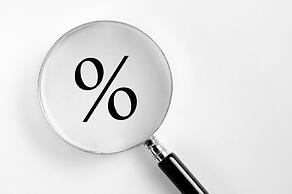 A typical beverage operation generates a constant stream of data and information, endless columns of figures and daily records. But you'd be surprised how few managers actually do anything with these figures, let alone fully grasp their implications. So how can you tell if you're operating profitably? The answer is you can't, unless, of course, you get to grips with some basic mathematics. For a start, you'll need to know how to perform a few simple calculations, such as working out an item's cost percentage. You don't need to be a mathematician to figure the following straightforward formulas:
A typical beverage operation generates a constant stream of data and information, endless columns of figures and daily records. But you'd be surprised how few managers actually do anything with these figures, let alone fully grasp their implications. So how can you tell if you're operating profitably? The answer is you can't, unless, of course, you get to grips with some basic mathematics. For a start, you'll need to know how to perform a few simple calculations, such as working out an item's cost percentage. You don't need to be a mathematician to figure the following straightforward formulas:
